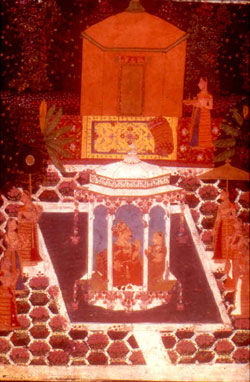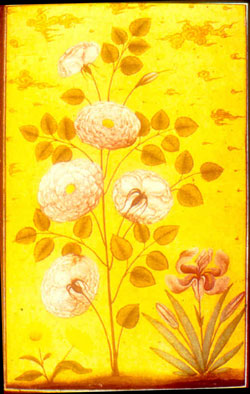"Oh! No man knows through what wild centuries roves back the rose"
; Walter de la Mare so rightly said.
A charming thought, but somewhat aggravating to rose- lovers who would like to know when the fascination of man for roses started. Even more frustrating for an Indian rose historian like me is the fact that there are no written records in India, covering periods where civilization was otherwise greatly advanced, like the Indus Valley Civilization (2500-1500 B.C.). Obviously the association of roses with India's history goes back to well over 5000 years. But, as earliest Indian history is based on oral tradition and not the written word, one has to depend on traditional myths, legends and folklore.
One such legend, widely related even today, harks back to the time when the Gods were said to live on earth. Brahma, the God of Creation, and Vishnu, the God of Protection had a debate about which flower was the most beautiful. Brahma favored the lotus while Vishnu preferred the rose. Upon being shown the arbor laden with lovely, fragrant roses in Vishnu's celestial garden, Brahma conceded the argument.
The presumption that such legends are rooted in reality is reinforced by the fact that the abode of the Gods has always been considered to be the Himalayas - this 1800 mile long sweeping chain of snow capped mountains, stretching from the north west to the north east of India, is also home to many wild rose species.
The medical treatises of the doctors, Charaka, a physician and Susruta, a surgeon — who, together are considered the founders of Ayurveda - the Indian system of medicine - ('ayurveda' literally translates as the 'science of life') and who are believed to have lived in the first century before Christ, have many references which give ample proof that roses were known in those days. The rose was known by many names, in the language of those times, Sanskrit, and each name was in fact an adjective symbolizing a particular characteristic, of its curative efficacy for a particular symptom or illness. Thus it was considered to be cooling, a laxative, an appetizer, it cured fever and boils, it lessened stomach burning.

Many other texts mention the rose in different contexts. One called 'Kashyapa's Agricultural Treatise' (c.800C.E.) lists the rose among other plants, trees and climbers that a king should plant within his kingdom. Another manuscript (Chakrapani Misra's 'Visva-vallabha', 15th century) states that the rose is an indicator of underground water.
When Alexander the Great invaded India, on its north-west border, in 327 B.C., it is said that he was amazed at the wealth of plants he beheld, and among others he sent back some rose plants to his mentor Aristotle.
Coming into the Christian era, the monk Vatsyayana, who wrote the 'Kama Sutra' (A Manual of Love) around 100 C.E., gives a list of the duties of a virtuous wife, and one of them is to tend a garden, which would have a number of flowering and fragrant plants, and the rose is one of them.
The poet Kalyana Malla's book, 'Ananga Ranga' (written about 1172 C.E.) describes the ambience of a room best suited for amorous interludes, and mentions the lavish use of rose water. Both these books have been translated by Sir Richard Burton. (19th century).
Though Avicenna (Ibn Senna) of Persia is credited with the discovery of rose water by distillation, the Ayurvedic text of Charaka, the doctor, has references to rose water, and the Buddhist sage, Nagarjuna, (1st century C.E.) who was an alchemist, describes the process of distillation in his scientific treatise, Arkaprakash.

Rose Edward
The rose used in those bygone days would, presumably, have been what was later referred to as Rosa damascena 'Bussorah'. Even today, rose water is made in India from this rose as also with Rose Edward which is called 'panneer' rose. 'Panneer' means rose water.
Trade with China existed from around 1000 B.C. as many Chinese scholars came to India, the land of the Buddha. When the Buddhist travellers Fa Hien and Hiuen Tsang (5th and 7th centuries) visited many of the sacred places associated with the Buddha, they mention in their writings the beautiful gardens, replete with roses and many other flowers and fountains that they saw and marvelled at.
The 'Gita Govinda' of poet Jayadeva (written in 1150 C.E.) and translated by Sir Edwin Arnold in 1879 as 'The Song of Songs' (who is more known for his 'Light of Asia') is replete with references to roses.
A Muslim traveller to India, Rashid-ud-din (1247-1317 C.E.) who is considered by Percy Browne to be the most reliable of Persian historians, visited the western Indian state of Gujerat in 1300 C.E. and remarked (I quote) "the people are very wealthy and happy and grow no less than 70 kinds of roses".
From the 14th to the 16th centuries one of the greatest and most splendiferous of dynasties was the Vijayanagar Kingdom of southern India. Two Portuguese travellers, Domingo Paes and Fernaz Nuniz who visited this kingdom in 1537 were amazed to see that roses were integral to the daily life of both aristocrats and commoners. They saw plantations of roses in the countryside, and the bazaars of the capital city of Hampi had many shops with baskets laden with roses. Men and women adorned themselves with roses. And the king of the time, the mighty Krishna Deva Raya, a great scholar-poet-warrior, dressed in silken robes of pure white embroidered with golden roses, would, every morning, when he gave audience, shower his favorite horses and elephants and courtiers, with white roses. The king's bedchamber (and I quote) " had pillars of carved stone, the walls all of ivory, as also the pillars of the cross-timbers, which at the top had roses carved out of ivory, all beautifully executed and so rich and beautiful that you would hardly find anywhere another such".

Another traveler, Abdur Razzak who visited this kingdom earlier in 1443 writes "Roses are sold everywhere. These people could not live without roses and they look upon these as quite as necessary as food".
An Italian traveller, Ludovico de Varthema, from Bologna, visited the western coast of India to a port called Calicut in 1503 and he writes that he saw innumerable flowers, and especially roses – red, white and yellow.
In the 16th century the Muslim Mughal emperors came from Persia and Afghanistan to rule India. The first emperor, Babur, (1483-1530) brought camel loads of roses- most probably musk and damask roses. His love for roses is epitomized by his poem:
'My heart, like the bud of the red, red rose,
Lies fold within fold aflame,
Would the breath of even a myriad Springs
Blow my heart's bud to a rose?'
He was so enamoured of roses that he gave all his daughters rose names – Gul chihra (rose-cheeked), Gulrukh (rose-faced), Gulbadan (rose-body) and Gul rang (rose colour). Gul means rose in Persian.
Babur developed the formal geometric 'char bagh' (four quadrants) design of Mughal gardens, where many roses were planted. This style was refined by later kings and the Mughal gardens in Kashmir, called the Shalimar garden, and in Agra, in the Taj Mahal, and in Delhi, the capital, were world famous.
Emperor Akbar, the 3rd Mughal Emperor, (1556-1605) invariably took camel loads of roses to give to the wives of his allies.
The next Mughal Emperor Jehangir's wife, Nur Jehan is credited with the discovery of rose oil, called attar in Persian, while she was taking a rose scented hot bath.
The finest of rose liquers was distilled for the aristocracy – about 20, 000 flowers for one bottle of liquer.
Manucci, the 17th century Italian traveler was amazed to see that the nobles not only used huge quantities of rose water and oil on themselves, but even rubbed their horses with these as a matter of course.
Nearly every painting of this period shows the subject of the painting holding a rose in his or her hand.
